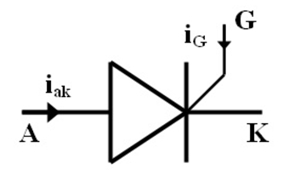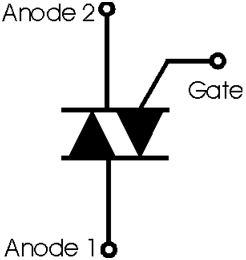Home › Electrical Engineering Forum › General Discussion › Types of Thyristors
- This topic has 3 replies, 3 voices, and was last updated 9 years ago by
Anonymous.
-
AuthorPosts
-
2014/11/07 at 5:11 pm #11208
admin
KeymasterNasir shares a brief overview of the different types of thyristors available and how are they categorized…Enjoy!
One of the most interesting things about thyristors is that they are manufactured in a unique way by the process of diffusion. We have already studied the working characteristics of a thyristor and how the gate signal acts in switching the device on and off. When the device is switched on, it takes a bit of time for the anode current to propagate through the junction, since we know that a thyristor is composed up of three junctions.
So for initiating this activity, we use the gate signal, so the gate is essentially one of the most sensitive and important part of the thyristor. Due to this fact the manufacturers pay special attention to the gate structures while manufacturing a thyristor.
Turn on and turn off time
The gate structure also affects some other properties of a thyristor which include:
- Current Propagation Time
- Turn on time of a thyristor
- Turn off time of a thyristor
Now considering the turn on and turn off time of a thyristor, we see that the thyristor can be easily turned on by a short gate pulse of the required amplitude. So turning on of a thyristor is not a big deal as long as one knows the requirements of the gate pulse. But in order for the thyristor to turn off we need a proper drive circuitry and a specially built internal structure to accomplish the turning off process of the thyristor.
Different types of thyristors are developed to efficiently accomplish the turning off process of the thyristor. A simple or conventional thyristor just have the turn on capability but new versatile types are being developed with better and more efficient turn off capabilities.
Major Types of Thyristors
Depending on the turn off and turn on capabilities and hence the physical structures, we categorize the thyristors into the following categories:
- Silicon Controlled Thyristors or SCRs
- Bidirectional Phase Controlled Thyristors or BCTs
- Fast Switching Thyristors or SCRs
- Bidirectional Triode Thyristors or TRIACS
- Light Activated Silicon Controlled Rectifiers or LASCRs
- Reverse Conducting Thyristors or RCTs
- FET Controlled Thyristors or FET-CTHs
- Gate turn off Thyristors or GTOs
- Emitter turn off thyristors or ETOs
- MOS turn off thyristors or MTOs
- Integrated Gate commutated thyristors or IGCTs
Commonly Used Thyristors
Out of these eleven types, the silicon controlled thyristors also known as SCRs are the most widely used in many electrical applications. It has the same four layered structure as a common thyristor and the current travels from anode to cathode when the thyristor is properly biased.
BCTs and TRIACs are bidirectional phase controlled thyristors as evident from their names above. This means that the current can travel in both directions in them.
The symbol of a bidirectional thyristor is shown below:
Other types are also used depending upon the need in the circuitry and the switching time required.
Most common uses of these types of thyristors include controlling alternating currents and applications where high voltage and current ratings are required. These applications are usually accomplished by SCRs whose electrical ratings are built for high voltage and current applications. SCRs are also used in the rectification of AC voltages.
On the other hand we find extensive uses of DIACS as well in electric power supplies such as in televisions. They are used to stabilize DC voltages received by the television receiver. They also find uses in electrical dimmers, motion pictures and theatres.
Before buying a thyristor, one should take care that he is well aware of his needs and the different types available in the market.
As said in the very beginning, this was a short sum up of the various types of thyristors. Some of the majorly used thyristors shall be explained in the upcoming tutorials as well.
Thanks for reading!2014/11/13 at 1:18 am #13633enhassan
Participantvery good
2015/05/18 at 11:01 am #13678Anonymous
Guestgood information on Thyristors , and thyristor types are very useful . Thanks for the post . Good stuff keep on posting new updates.
2015/11/20 at 4:14 am #13746Anonymous
Guestthanks for the info.
-
AuthorPosts
- You must be logged in to reply to this topic.

